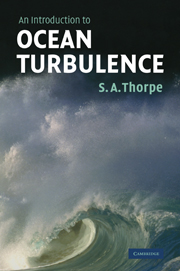Book contents
- Frontmatter
- Contents
- Preface
- Notes on the text
- Acknowledgements
- Abbreviations
- Standard parameters and symbols
- Units and their symbols
- SI prefixes
- Approximate values of commonly used measures
- 1 Turbulence, heat and waves
- 2 Measurement of ocean turbulence
- 3 Turbulence in oceanic boundary layers
- 4 Turbulence in the ocean pycnocline
- 5 Turbulent dispersion
- 6 The energetics of ocean mixing
- References
- Index
- Answers
3 - Turbulence in oceanic boundary layers
Published online by Cambridge University Press: 05 June 2012
- Frontmatter
- Contents
- Preface
- Notes on the text
- Acknowledgements
- Abbreviations
- Standard parameters and symbols
- Units and their symbols
- SI prefixes
- Approximate values of commonly used measures
- 1 Turbulence, heat and waves
- 2 Measurement of ocean turbulence
- 3 Turbulence in oceanic boundary layers
- 4 Turbulence in the ocean pycnocline
- 5 Turbulent dispersion
- 6 The energetics of ocean mixing
- References
- Index
- Answers
Summary
Introduction: processes, and types of boundary layers
This chapter is about turbulence in the two, very extensive, boundary layers of the ocean, the upper ocean boundary layer or region near the sea surface that is directly affected by the presence of the overlying atmosphere, and the benthic or bottom boundary layer (bbl) that lies above the underlying solid, but possibly rough and (in strong flows) mobile, seabed. Two fluxes imposed at the bounding surfaces have direct effects, those of buoyancy and momentum. The former is often dominated by a flux of heat, related by (2.8) to a flux of buoyancy. This is sometimes supplemented at the sea surface by the entry of buoyant freshwater in the form of rain or snow. The flux of momentum can be equated to the stress, as explained in Section 2.2.1. This stress, or horizontal force per unit area, may be exerted by the wind on the sea surface or, for example, by the frictional forces of an immobile sedimentary layer composed of sand or gravel on a current passing over the ocean floor.
It is useful here, as in preceding chapters, to refer to processes. By a ‘process’ is meant a physical mechanism, one that can be described in terms of its effects and its associated spatial and temporal structure, that generally involves the transfer of energy from one scale to another or from one part of the ocean to another.
- Type
- Chapter
- Information
- An Introduction to Ocean Turbulence , pp. 77 - 115Publisher: Cambridge University PressPrint publication year: 2007
- 1
- Cited by



